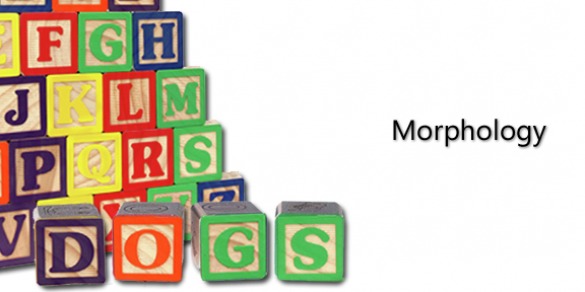the study of the structure and form of words; a vocabulary building strategy
Morphology Includes:
- It influences spelling, vocabulary, and reading comprehension success, allows students to separate morphemes within a word, individually define them and combine the definitions in order to understand a word they are unfamiliar with, and allows students to understand large words by knowing smaller morphemes or morpheme combinations.
Morphology Development:
- Young children/ Preschoolers
- Over-generalize word endings/suffixes (I goed to the store. The mouses were in our basement.)
- Novel use of words (I’m crayoning my paper. She puddinged her shirt.)
- 1st grade
- Evidence of correct inflection (snowed, rotted)
- 2nd grade
- Finding meanings of unfamiliar words using word parts
- Finding meanings of unfamiliar words using word parts
Examples
- courage - courageous - courageously - encourage - discourage - discouragingly
- relate - relates - related - relating - unrelated - relation - relations
- correlate - correlates - correlated - correlation - correlative
- construct - constructed - constructing - construction - constructions - constructive - constructs - reconstruct - reconstructed - reconstructing - reconstruction - reconstructs
Block, Meghan. (2010). Vocabulary and Morphology.
[PowerPoint Slides]. Retrieved from University of Michigan State.
[PowerPoint Slides]. Retrieved from University of Michigan State.
Vocabulary Related to Morphology:
- Morpheme: The smallest unit of meaning in a word; so if you know the meaning of the smallest units, you can figure out the meaning of the entire word (hypothetically)
- Morphemic analysis: Analyzing a word’s structure to predict meaning
- Free morphemes: Morphemes that can stand alone
- Bound morphemes: Morphemes that cannot stand alone (most prefixes and suffixes are bound morphemes)
- Root Morpheme: A morpheme can stand on its own with a meaning
- Suffix Morpheme: A morpheme that changes the meaning of a word and appears at the end of the given word.
- Example: (-s), (-ed), (-ly), (-er)
- Prefix Morpheme: A morpheme that changes the meaning of a word and appears at the beginning of the given word.
- Example: (re-), (ex-), (de-), (un-), (be-)
- Derivational Morphemes: Can appear as suffixes or prefixes in English but change the meaning of the root (i.e. the root becomes the opposite meaning) or the class of the word (i.e. changes from a noun to a verb) and can affect the pronunciation of the root
- Inflectional Morphemes: Only appear as suffixes in English, only works with a specific class of words, and changes its sound based on the last sound of the root word. There are only eight inflectional morphemes in the English language
- Morphological Awareness: Associated with spelling, vocabulary, and reading comprehension success. In English, morphology has a huge influence on spelling. In fact, meaning often overrides phonology in English spelling.
- Example: magic/magician, sign/signature, and grace/gracious
Block, Meghan. (2010). Vocabulary and Morphology.
[PowerPoint Slides]. Retrieved from University of Michigan State.
[PowerPoint Slides]. Retrieved from University of Michigan State.
Ways to Help Students Develop Morphology:
- When a child encounters a word with one or more morphemes, his/her ability to separate the morphemes, individually define the morphemes, and then combine them to determine a new meaning determines how well s/he will be able to “get” the new word.
- Example: toes with the morphemes toe and s.




